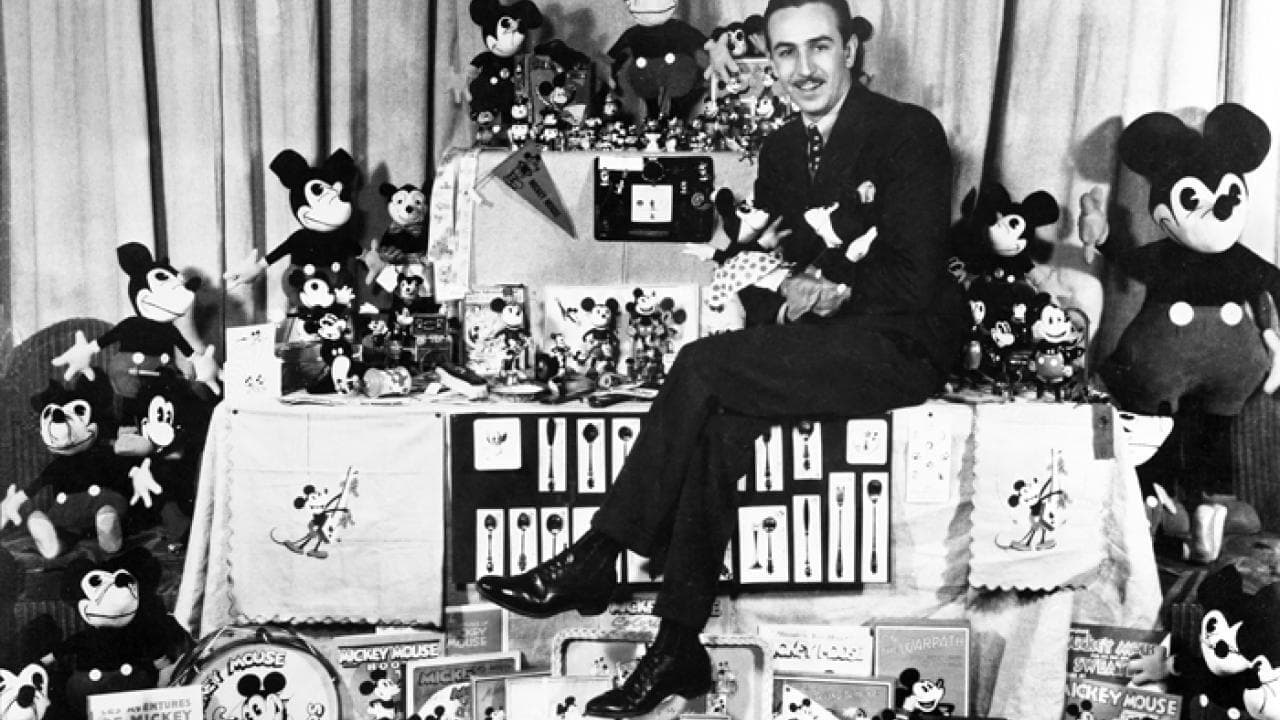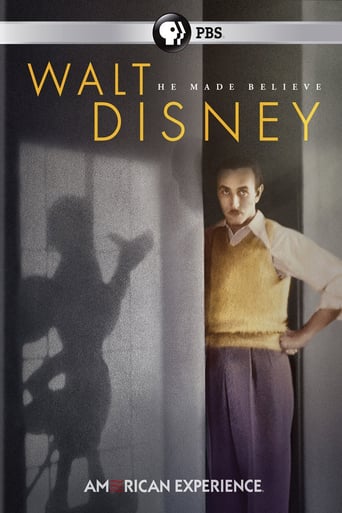



This Movie Can Only Be Described With One Word.
ridiculous rating
Expected more
Don't listen to the negative reviews
The Walt Disney American Experience PBS documentary is a good profile of a box of contradictions: a wholesome 'family' man and a rabid anti-communist conservative who was one of the heads of the Alliance that made things horrible for people in Hollywood for years (and what a speech he gives to his workers that made them organize *more* to strike in 1941); someone who claimed he wanted things simple and wasn't "literary" while creating one of the great abstract experimental films (Fantasia) and changing an artistic medium through his "fairy tales" and silly symphonies and Disneyland and so on.This is a very fair document of a man who created many of the films that made children around the world cry and laugh and (occasionally, as in part of the forest sequence in Snow White) pee themselves, while also being "hard-driving" while being inspirational for his workers (or those who stuck around).It's chock-a-block of great clips and somewhat obvious but nevertheless enlightening analyses of the "Big Five" first films (Snow White, Pinocchio, Dumbo, Bambi and Fantasia), and on to things from television like Walt Disneyland TV and the park itself. Here's a man who could do anything and for the better part of his later life got obsessed with trains and led on to making THE amusement park of the world (or as one interviewee calls it "a living animation"). From a portrait like this it's somewhat easy to call him difficult (he likely was), but it's rare to get someone in America who was a genuine entertainer - whether it connected with everyone, as he aimed for whether it was a Donald Duck cartoon or the blades of grass in the park, he had to make it just so - while being so, uh, 'wholesome' (depending on who you talk to of course).He's a wonderful bunch of contradictions, which is something we can relate to even as we're not all "visionaries" and such.
View MoreI am usually a huge fan of "The American Experience" and have watched dozens and dozens of their episodes. This is one of the first that I didn't particularly like--much of it because the film seemed less concerned with a chronological approach to Walt Disney's life. Instead, the film was looking for a darker side--a darker side that didn't always exist. Here are a couple examples:The strike at Disney in the early 40s WAS hard on the company and hard on Walt Disney. He was instrumental in trying to block unionization--that is true. But the film also seemed to say that he had an agenda to 'get back' at those responsible for the union--like Walt was a super-spiteful guy. Perhaps he was at times, but this didn't exactly jibe with biographies I read about the guy.The show concentrated A LOT on "Song of the South" and totally ignored a lot of other films that came out in the same time period. Between "Dumbo" and "Song of the South" were several Disney full- length films that didn't get mentioned and there were many films AFTER "Song of the South" that didn't get mentioned. "Song of the South" was mentioned because it offends many people's sensitivities today--and no other apparent reason. It wasn't one of the big classic hits made by the studio. Were they trying to say Walt was a bigot? Most evidence (such as his hiring practices at the company and treatment of non-white guests at Disneyland) would seem to indicate he wasn't. So why concentrate so hard on this one film?The bottom line is that instead of trying to tell Walt's life, the show was looking for a darker side and to promote a common theme to "American Experience" shows--race. To me, this isn't necessarily the most honest approach to a biography--more like a nod to political correctness as well as to create controversy.
View MoreAmerican Experience: Walt Disney (2015)**** (out of 4)This two-part look at the life and career of Walt Disney certainly has some flaws. I will openly admit that but at the same time there's so much great knowledge and footage here that it's almost silly to complain too much about it.The first part of the documentary covers Walt's early days and how he got interested in going into show business. We learn about his earliest animated movies and how he ended up broke before finally getting money with the Alice shorts. From here we learn about various issues that happened with his family and how a little mouse would end up saving his career. From here we see the building of Disney Studios as well as him dreaming of doing feature films.The second portion of the film deals with some of the darker and more controversial moments including various strikes by his workers who felt they were being mistreated. The studio's disappointing box office returns to movies like BAMBI and DUMBO are also discussed but the main focus is Disney Land and how television would help bring Walt's vision to life. We also take a look at some of his latest pictures, which were attacked during a time when people didn't see peace and happiness instead they were seeing shocking images of violence.The biggest problem with this documentary is that its four hour running time simply isn't long enough to fully get into this man. I will admit that I didn't know too much about his personal story so I found this documentary to be full of wonderful knowledge and there's no question that all the footage from his movies as well as the personal movies were terrific. Even more entertaining was seeing Disney Land being built and just looking at the footage makes it a wonder that the vision ending up coming true. The film certainly is extremely long but it's never boring and it's definitely worth seeing.
View More"American Experience: Walt Disney" is a two-part four-hour documentary about the life and career of Walt Disney--animator, entrepreneur, visionary. It takes a pretty standard approach to its subject, mixing contemporary interviews with various talking heads (biographers, academics, Disney animators) with plentiful archival footage of its subject from a period of over 40 years, along with clips from numerous Disney productions. While the piece is not exactly a paean to Disney and certainly does not emanate from the Disney Studio publicity machine, it's not a wholesale attack on him either. It does offer a critical look at Disney's relationship with his staff and his sometimes contentious relationship with his brother Roy, who was also his business partner and the one who oversaw the studio's financial health. Walt had a vision and he sought to bring it to reality come hell or high water, the banks and unions be damned. One can admire his technical accomplishments and revel in the breathtaking artistry of his most significant works, but still take a jaundiced look at the way Disney's output, from his animated features to his TV shows and theme parks, watered down the complexity of human life and history and polished down the rough edges to promote a glossy worldview of a middle-class, racially homogeneous society with conservative values and idealized standards of beauty.Part 1 offers an abundance of footage from Disney's early days in Kansas City, including clips from his earliest cartoons ("Laugh-o-grams") and pictures of him and his partners (including Ub Iwerks) at work. It follows him to California and his efforts to find a distributor for his films and create his own company. He had numerous setbacks, including losing the rights to his character, Oswald the Rabbit, but he persevered and found worldwide success with Mickey Mouse and Silly Symphonies. Eventually, Part 1 settles on the creation of SNOW WHITE AND THE SEVEN DWARFS (1937) and the extraordinary risks Disney took in crafting a feature-length animated film and the expenses incurred. We even see footage of its Hollywood premiere and get a blow-by-blow account of the audience reaction, one of the best sequences in the whole documentary. Disney then plunges into PINOCCHIO, FANTASIA and BAMBI, despite the impending world war and the eventual loss of the lucrative European market.Part 2 opens with the 1941 strike that imperiled the studio and Disney's angry break with animator Art Babbitt, one of the leaders of the strike. (Babbitt eventually went back to work for Disney, a fact that goes unmentioned in the documentary.) SONG OF THE SOUTH (1946) is covered, along with the backlash by the NAACP against its treatment of racial themes, and some attention is given to Disney's testimony as an anti-communist "friendly witness" before the House Un-American Activities Committee. In the 1950s, Disney becomes increasingly obsessed with model railroads (encouraged by one of his top animators, Ward Kimball) and even builds one on his property that's large enough for Disney and various child visitors to ride around on, seen in ample home movie footage. The next big focus is Disneyland and Walt's efforts to design and build it and open it on schedule. Numerous minor disasters disrupt the opening day and these extend to the celebrity-packed live TV broadcast of the day's festivities, seen in lots of footage preserved from the event. Disneyland occupies most of Part 2 before the focus shifts to MARY POPPINS (1964), the subject of the 2013 Disney feature, SAVING MR. BANKS (unmentioned here), the plans for EPCOT and, finally, Disney's death.The talking heads include at least four authors who've written books about Disney, some critical, some favorable: Richard Schickel, Neal Gabler, Michael Barrier, and Steven Watts. Their insights are always welcome and will hopefully propel viewers to read their books. (I've read two of them and have acquired a third.) There are a number of academics who contribute their thoughts, although I could have done without most of them. There is one African-American female art historian, Carmenita Higginbotham, who weighs in on the SONG OF THE SOUTH controversy. While she's critical of Disney on that issue, she actually offers a number of favorable assessments of other aspects of Disney's work throughout the documentary, all delivered with a refreshing degree of enthusiasm and affection.Finally, I was very pleased to hear from a trio of Disney animators and designers who had worked with Disney in the 1930s and are still around to talk about it: Ruthie Thompson, Don Lusk, and Robert Givens. (Don Lusk is over 100 at this point—and didn't look a day over 80!) Which begs the question of why there wasn't more footage of interviews from past documentaries about Disney. "Frank and Ollie" from 1995, for instance, offered profiles of two of Disney's famous "nine old men," Frank Thomas and Ollie Johnston. Ward Kimball was interviewed on several occasions and he's prominently featured along with other veteran Disney personnel in "It All Started with a Mouse: The Disney Story" (1989), which I've also reviewed on this site and which had amazing behind-the-scenes footage from the 1930s and '40s that would have been useful in this documentary. I also wondered where Leonard Maltin was. Why wasn't he interviewed for this? He certainly knows as much about Disney as any of the featured interviewees. Is he too closely tied to the Disney Company and was he ordered not to participate? Or did the filmmakers simply not approach him? In any event, Disney remains one of the most fascinating entertainment figures of the 20th century and he left a huge footprint on American culture. He's one of the few film and TV industry pioneers who is still widely known among young people. This two-parter is well worth seeing by anyone who's interested in Disney, although I'm sure there is enough footage and material for a whole documentary series on him that I hope will one day emerge.
View More